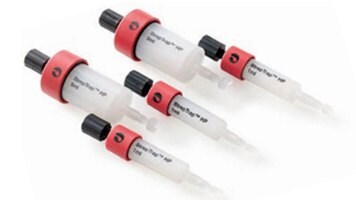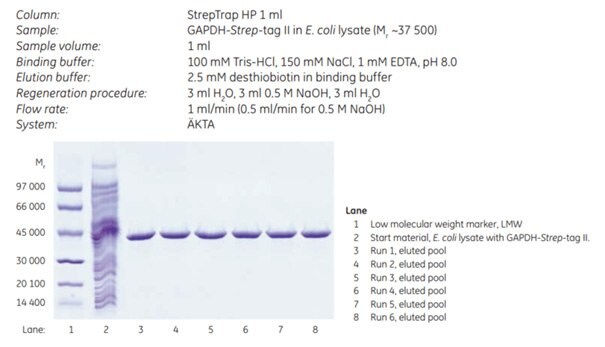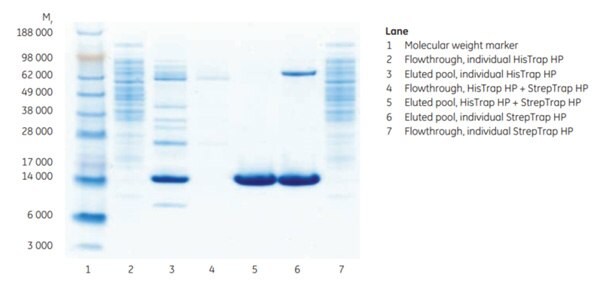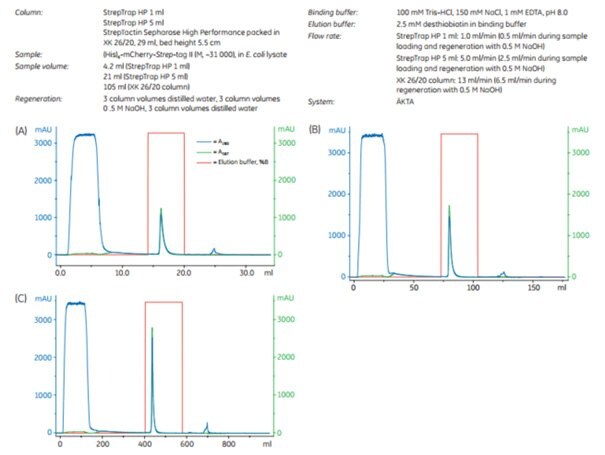Purification using StrepTrap™ HP 1 mL and 5 mL
StrepTrap™ HP 1 mL and 5 mL columns are made of biocompatible polypropylene that does not interact with biomolecules (Figure 7.2). Prepacked StrepTrap™ HP columns provide fast, simple, and easy separations in a convenient format. They can be operated with a syringe, a laboratory pump, or a liquid chromatography system such as ÄKTA.
StrepTrap™ HP columns are delivered with a stopper on the inlet and a snap-off end on the outlet. Porous top and bottom frits allow high flow rates. StrepTrap™ HP columns belong to the HiTrap™ family of prepacked columns. Note that HiTrap™ columns cannot be opened or refilled.
Table A4.3 (Appendix 4, Characteristics of StrepTactin Sepharose High Performance products) summarizes the characteristics of prepacked StrepTrap™ HP columns.

Figure 7.2.StrepTrap™ HP 1 mL and 5 mL columns quickly and conveniently purify Strep-tag II recombinant proteins to high purities in concentrated forms and small volumes.
Sample preparation
Adjust the sample to the composition of the binding buffer (below). For example, dilute the sample with binding buffer or buffer exchange using a desalting column (Chapter 11, Desalting/buffer exchange and concentration).
Pass the sample through a 0.22 µM or a 0.45 µM filter and/or centrifuge it immediately before applying it to the column. If the sample is too viscous, to prevent it from clogging the column dilute it with binding buffer, increase lysis treatment (sonication, homogenization), or add DNase/RNase to reduce the size of nucleic acid fragments.
Buffer preparation
Appendix 4 (Characteristics of StrepTactin Sepharose High Performance products) for details on regeneration of StrepTrap™ 1 mL and 5 mL.
Water and chemicals used for buffer preparation should be of high purity. Filter buffers through a 0.22 µM or a 0.45 µM filter before use.
Purification
- Fill the syringe or pump tubing with binding buffer. Remove the stopper and connect the column to the syringe (with the connector provided) or pump tubing “drop to drop” to avoid introducing air into the column.
- Remove the snap-off end at the column outlet. Wash out the ethanol with at least 5 column volumes of distilled water or binding buffer.
- Equilibrate the column with at least 5 column volumes of binding buffer at 1 mL/min or 5 mL/min for 1 mL and 5 mL columns, respectively.
- Apply the sample using a syringe fitted to the Luer connector or by pumping it onto the column.
- Wash with 5 to 10 column volumes of binding buffer or until no material appears in the effluent.
- Elute with 6 column volumes of elution buffer. The eluted fractions can be buffer exchanged using a prepacked desalting column (Chapter 11, Desalting/buffer exchange and concentration).
- After elution, the column can be regenerated by following the procedure described in Appendix 4 (Characteristics of StrepTactin Sepharose High Performance products).
Scaling up from 1 mL to 5 mL StrepTrap™ HP columns is easily performed by increasing sample load and flow rate five-fold. An alternative method for quick scale-up is to connect two or three StrepTrap™ HP columns in series (back pressure will increase). Figure 7.5 for an example of scale-up.
StrepTrap™ HP columns are fast and are easily regenerated with 0.5 M NaOH.
Store StrepTrap™ HP columns in 20% ethanol at 2 °C to 8 °C. After storage, equilibrate with binding buffer before use.
Application examples
1. Rapid and effective regeneration
The regeneration of StrepTrap™ HP is easily performed using sodium hydroxide (0.5 M NaOH). Six consecutive purifications of glyceraldehyde-phosphodehydrogenase (GAPDH)-Strep-tag II in E. coli lysate were performed with regeneration between the runs (Figure 7.3). The load was 1 mg of GAPDH-Strep-tag II.
The final purity and yield of the target protein were almost identical, with no tendency of decreasing values. The purity was above 95% according to SDS-PAGE (Figure 7.3), and the yield was approximately 0.85 mg (85%) for all six runs. These results show the high reproducibility during repeated use of StrepTrap™ HP in combination with regeneration with 0.5 M NaOH.

Figure 7.3.Repeated purification and regeneration on the same StrepTrap™ HP column. SDS-PAGE analysis (reducing conditions, Coomassie stained) of eluted pools from six purification runs on the same StrepTrap™ HP column including regeneration with 0.5 M NaOH between each run.
2. Increased purity with a two-step affinity purification of a dual-tagged protein
In most cases, sufficient purity is obtained in single-step affinity purification of Strep-tag II fusion proteins using StrepTactin Sepharose. Should this not be case, a solution is to introduce a second affinity tag. In this example, a dual-tagged Strep-tag II-(histidine)6 protein (Mr ~15 400) expressed in E. coli was purified for method development of functional studies. The two-step procedure comprised IMAC on HisTrap™ HP (prepacked with Ni Sepharose High Performance) followed by AC on StrepTrap™ HP. As high purity is crucial for successful functional studies, purity results of the two-step method were compared to the IMAC and AC steps individually. All runs were performed on ÄKTAxpress at 4 °C.
The conditions used are as follows:
SDS-PAGE analysis (Figure 7.4) showed that the individual HisTrap™ HP purification yielded the target protein and a number of different impurities (lane 3). StrepTrap™ HP on its own also yielded the target protein, this time with one impurity (lane 6). In contrast, the combination of HisTrap™ HP followed by StrepTrap™ HP resulted in a target protein with a purity greater than 95% (lane 5).
This example clearly demonstrates the benefits of a dual-tagged approach to protein purification, especially when high purity is needed. HisTrap™ HP and StrepTrap™ HP run in sequence on ÄKTAxpress fulfilled the requirements for a fast and efficient chromatography system capable of delivering such results.

Figure 7.4.SDS-PAGE analysis (reducing conditions) comparing individual purifications on HisTrap™ HP 1 mL and StrepTrap™ HP 1 mL with a combined, two-step affinity purification on both columns. Data kindly provided by Martina Nilsson, Robert Svensson, and Erik Holmgren, Biovitrum, Stockholm, Sweden.
3. Scale-up from 1 mL to 5 mL to 29 mL column
Scale-up can be achieved by increasing the bed volume while keeping the residence time constant. This approach maintains chromatographic performance during scale-up.
The protein used was a dual-tagged fluorescent protein, (his)6-mCherry-Strep-tag II (Mr 31 000), in E. coli lysate, which can be detected at 587 nm as well as 280 nm. Purification on a StrepTrap™ HP 1 mL column was first performed and then scaled up to the 5 mL column followed by further scale-up to a 29 mL XK 26/20 column packed with StrepTactin Sepharose High Performance (bed height 5.5 cm). The residence time was ~2 min for all columns. Figure 7.5 shows the chromatograms and running conditions.
Protein load was increased five-fold for the scale-up from the 1 mL StrepTrap™ HP column to the 5 mL column and 25-fold in the scale-up from the 1 mL StrepTrap™ HP column to the 29 mL XK 26/20 column. Yield, calculated from absorbance measurements, was 2.2, 9.4, and 52.7 mg, respectively (Table 7.1). SDS-PAGE (data not shown) showed that the purity of the fractions eluted from the columns was similar.
The columns gave comparable results, confirming the ease and reproducibility of scaling up purifications from StrepTrap™ HP columns to a larger, XK 26/20 column packed with StrepTactin Sepharose High Performance.

Figure 7.5.Scaling up the purification of (His)6-mCherry-Strep-tag II, (A) StrepTrap™ HP 1 mL, (B) StrepTrap™ HP 5 mL, (C) StrepTactin Sepharose High Performance XK 26/20 with 5.5 mL bed height, 29 mL.
Materials
To continue reading please sign in or create an account.
Don't Have An Account?